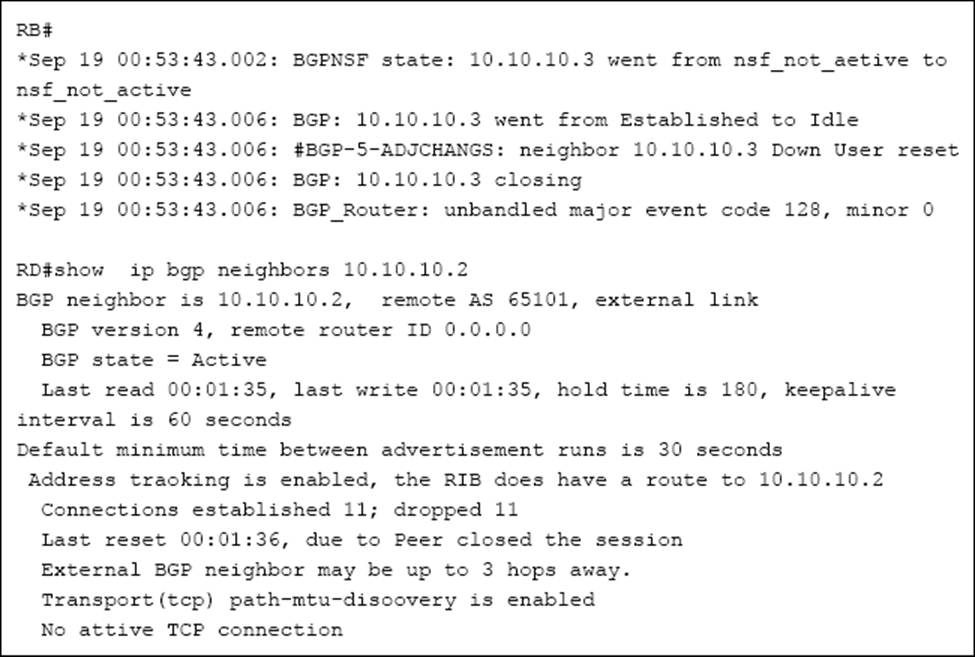Practice Free 300-410 Exam Online Questions
Refer to the exhibit.

A NOC team receives a ticket that data traffic from RA to RF is not forwarded when the link between the RC-RE path goes down. All routers learn loopback IP through the IGP protocol.
Which configuration resolves?
- A . RD(config)#router bgp B5201
RD(config-router)# neighbor 10.10.10.2 update-source loopback 0 - B . RD(config-router)# neighbor bgp 65101
RB(config-router)# neighbor 10.10.10.3 ebgp-multihop 3 - C . RB(config)# router bgp 65101
RB(config)#neighbor 10.10.10.3 update-source loopback 0 - D . RD(config)# router bgp 65201
RDI(config-router)# neighbor 10.10.10.2 ebgp-multihop 3
Refer to the exhibit.

A network engineer is troubleshooting a failed link between R2 and R3 No traffic loss is reported from router R5 to HQ.
Which command fixes the separated backbone?
- A . R2(config-router)#no area 21 stub
- B . R2(config_router)#area 21 virtual-link 192.168.125.5
- C . R3(config-router)#area 21 virtual-link 192.168.125.5
- D . R3(config-router)#no area 21 stub
Which protocol does VRF-Lite support?
- A . IS-IS
- B . ODR
- C . EIGRP
- D . IGRP
While BGP internet routes are redistributed to a lower class of router via RIP. packets are being dropped and routes are failing to be distributed in RIP.
Which action resolves the issue?
- A . Use OSPF instead of RIP to accept all BGP routes.
- B . Use the input-queue command to prevent the loss of packets.
- C . Use WFQ in the output queue of the high-performance router.
- D . Use RIP V2 to be able to use classless networks from BGP
Which IP precedence value does BFD use to prioritize traffic within an infrastructure device?
- A . 4
- B . 5
- C . 6
- D . 7
A network administrator added a new spoke site with dynamic IP on the DMVPN network.
Which configuration command passes traffic on the DMVPN tunnel from the spoke router?
- A . ip nhrp registration ignore
- B . ip nhrp registration no-registration
- C . ip nhrp registration dynamic
- D . ip nhrp registration no-unique
Refer to the exhibit.

Which statement about R1 is true?
- A . OSPF redistributes RIP routes only if they have a tag of one.
- B . RIP learned routes are distributed to OSPF with a tag value of one.
- C . R1 adds one to the metric for RIP learned routes before redistributing to OSPF.
- D . RIP routes are redistributed to OSPF without any changes.
Which method changes the forwarding decision that a router makes without first changing the routing table or influencing the IP data plane?
- A . nonbroadcast multiaccess
- B . packet switching
- C . policy-based routing
- D . forwarding information base
Which method changes the forwarding decision that a router makes without first changing the routing table or influencing the IP data plane?
- A . nonbroadcast multiaccess
- B . packet switching
- C . policy-based routing
- D . forwarding information base
Which configuration enabled the VRF that is labeled “Inet” on FastEthernet0/0?
- A . R1(config)# ip vrf Inet
R1(config-vrf)#interface FastEthernet0/0
R1(config-if)#ip vrf forwarding Inet - B . R1(config)#router ospf 1 vrf Inet
R1(config-router)#ip vrf forwarding FastEthernet0/0 - C . R1(config)#ip vrf Inet FastEthernet0/0
- D . R1(config)# ip vrf Inet
R1(config-vrf)#ip vrf FastEthernet0/0
